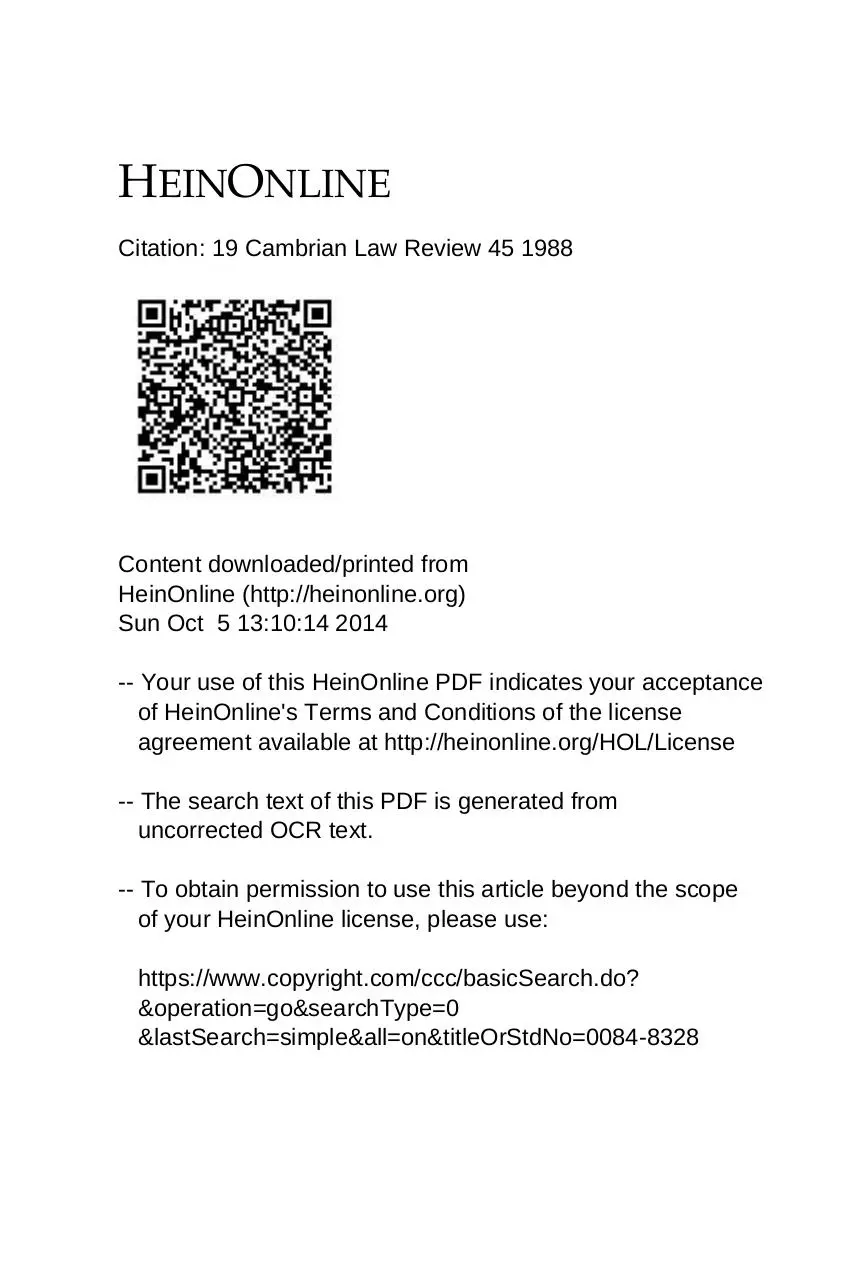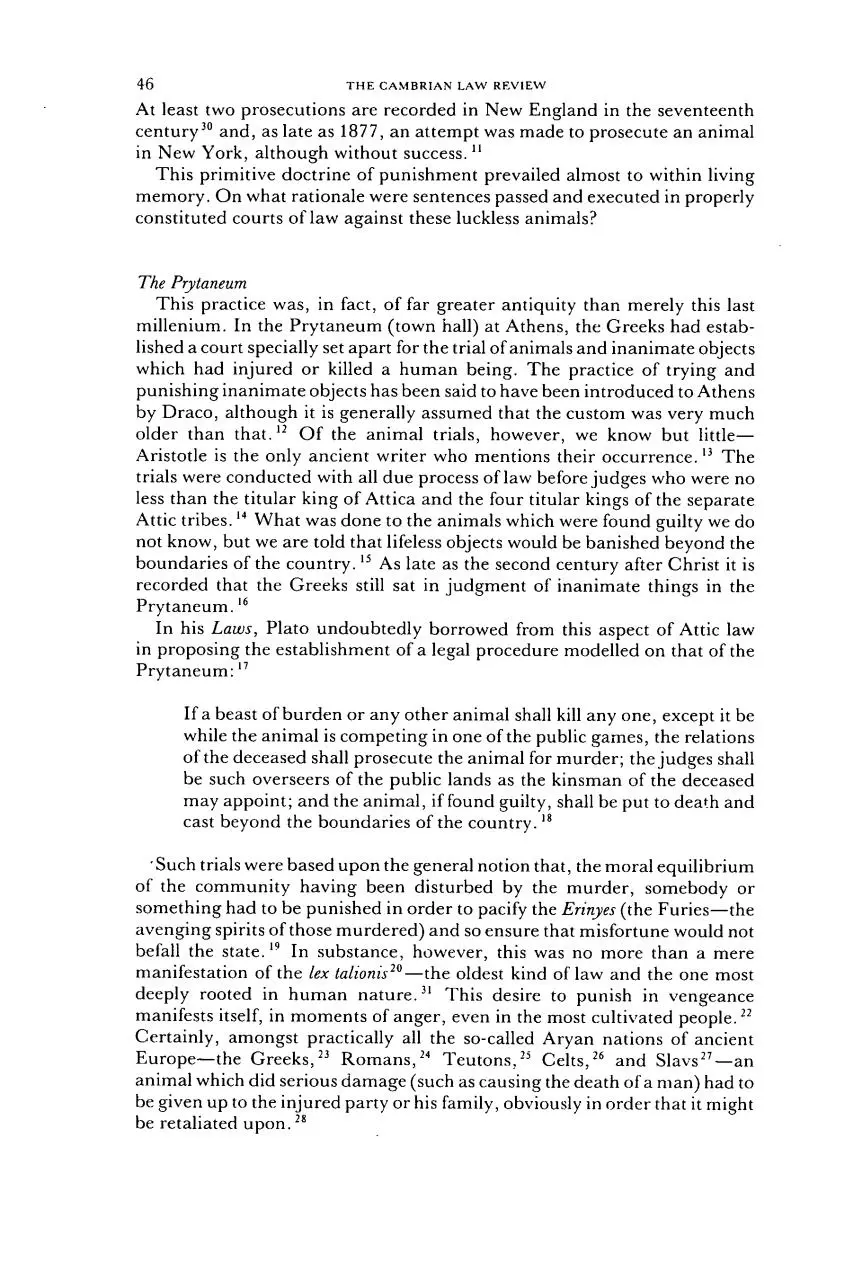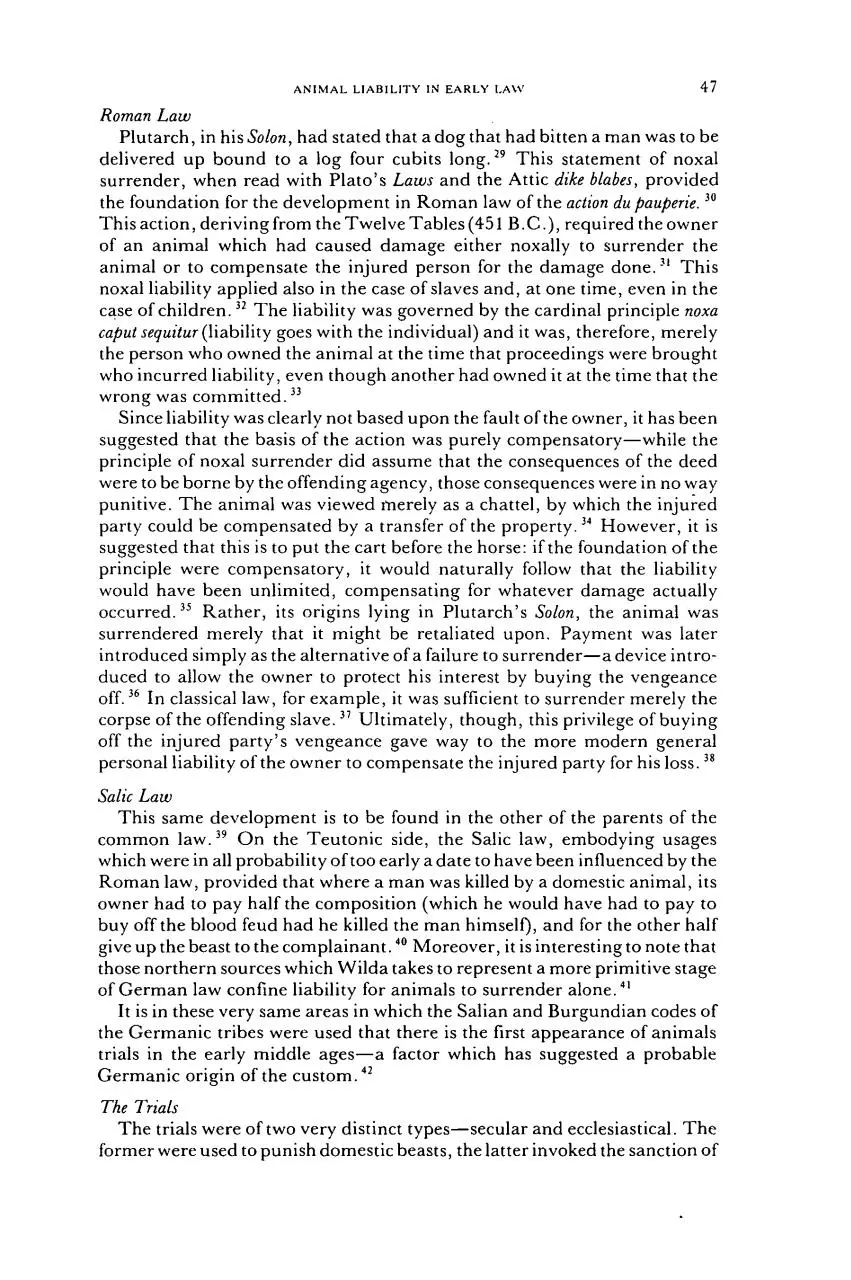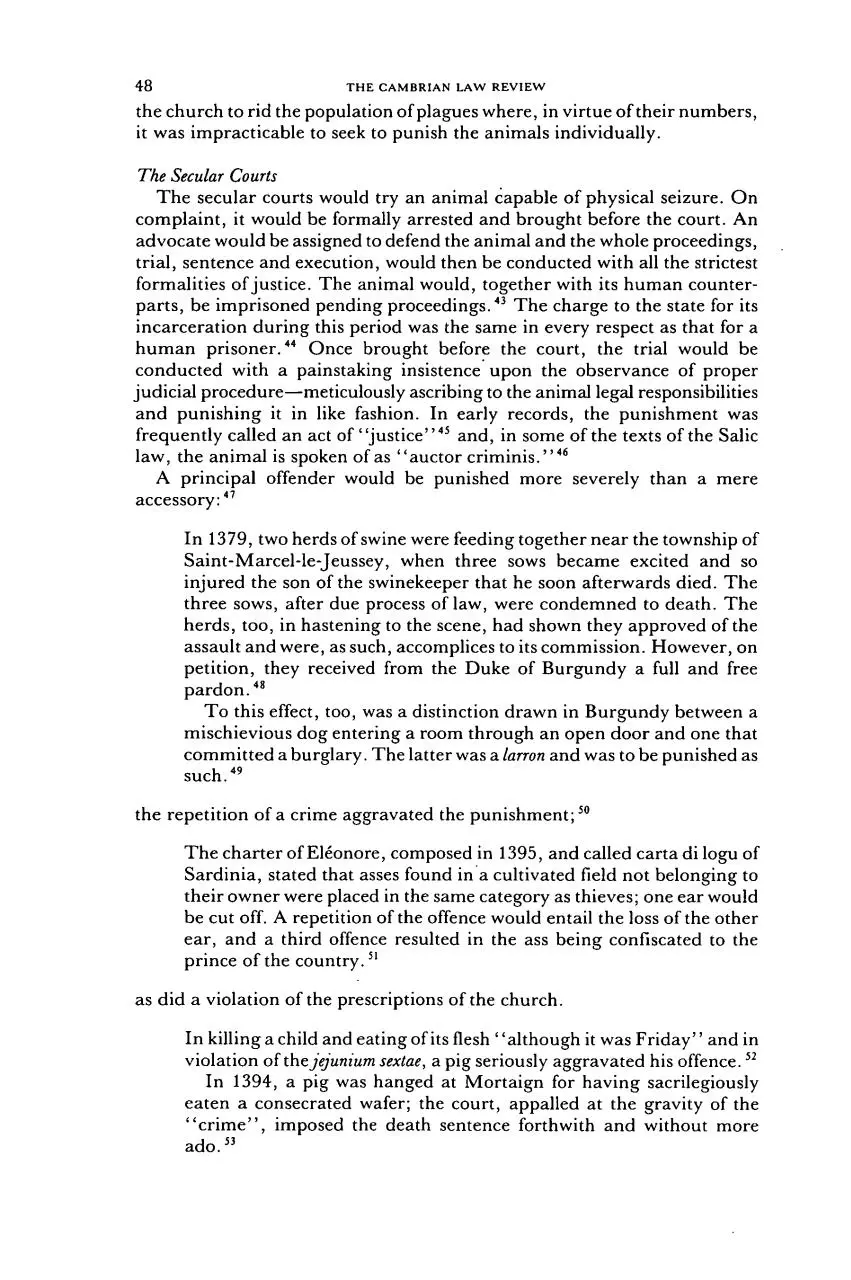19CambrianLawReview45 (PDF)
File information
This PDF 1.4 document has been generated by , and has been sent on pdf-archive.com on 05/10/2014 at 19:13, from IP address 62.98.x.x.
The current document download page has been viewed 590 times.
File size: 1.4 MB (25 pages).
Privacy: public file





File preview
+(,121/,1(
Citation: 19 Cambrian Law Review 45 1988
Content downloaded/printed from
HeinOnline (http://heinonline.org)
Sun Oct 5 13:10:14 2014
-- Your use of this HeinOnline PDF indicates your acceptance
of HeinOnline's Terms and Conditions of the license
agreement available at http://heinonline.org/HOL/License
-- The search text of this PDF is generated from
uncorrected OCR text.
-- To obtain permission to use this article beyond the scope
of your HeinOnline license, please use:
https://www.copyright.com/ccc/basicSearch.do?
&operation=go&searchType=0
&lastSearch=simple&all=on&titleOrStdNo=0084-8328
ANIMAL LIABILITY IN EARLY LAW
PHILIP JAMIESON*
The law embodies the story of a nation'sdevelopment through many centuries, and
it cannotbe dealt with as ifit containedonly the axioms and corollariesof a book of
mathematics. '
One such axiom is that of the liability of an owner for the conduct of his
animal. However, as recently as a few generations ago, its corollary-that an
animal was not itself the subject of legal liability-was a concept still not
recognised in some modern jurisdictions. Since the present must depend
very much upon the past, in understanding the modern axiom of liability, it
is useful to remind ourselves that the criminal prosecution and punishment of
animals was a practice which survived even into the twentieth century.
More than two hundred such prosecutions have been chronicled, 2 the last
to take place in 1906 in the village of D6l6mont in Switzerland when a dog was
put to death as an accomplice to murder. 3 As late as 1916, it was reported
that animals were then still being tried and punished by the mountaineers of
Kentucky and Tennessee in the United States. 4
Of one hundred and ninety-one such prosecutions tabled by E. P. Evans in
his book on this subject, 5 the author assigns their number to the centuries as
follows:
9th
10th
llth
12th
3
3
13th
14th
15th
16th
2
12
36
57
17th
18th
19th
20th
56
12
9
1
However, the records of these prosecutions, spanning the period from A. D.
824, when moles were prosecuted in the valley of Aosta, until last recorded in
1906, almost certainly represent only a very small percentage of those which
actually took place.
The proceedings, best documented in France, occurred in almost every
European country-Belgium, Denmark, Russia, Germany, Italy, Portugal,
Spain, Turkey, England and Scotland-as well as in the United States,
Canada and Brazil. 6 The Russians, true to their historic mode of punishment,
are known to have banished a he-goat to Siberia toward the end of the
seventeenth century.' Two such prosecutions have been recorded as having
taken place in England-a dog at Chichester in 1771 and a cock at Leeds in
the nineteenth century, and one in Scotland-a dog in the first half of the
sixteenth century. 8 However, that they were a commonplace in England
during the Elizabethan Age seems evident from a passage in Gratiano's
invective against Shylock in Shakespeare's Merchant of Venice:9
"Thy currish spirit
Govern'd a wolf, who, hang'd for human slaughter.
Even from the gallows did his fell soul fleet."
46
THE CAMBRIAN LAW REVIEW
At least two prosecutions are recorded in New England in the seventeenth
century 30 and, as late as 1877, an attempt was made to prosecute an animal
in New York, although without success. "I
This primitive doctrine of punishment prevailed almost to within living
memory. On what rationale were sentences passed and executed in properly
constituted courts of law against these luckless animals?
The Prytaneum
This practice was, in fact, of far greater antiquity than merely this last
millenium. In the Prytaneum (town hall) at Athens, the Greeks had established a court specially set apart for the trial of animals and inanimate objects
which had injured or killed a human being. The practice of trying and
punishing inanimate objects has been said to have been introduced to Athens
by Draco, although it is generally assumed that the custom was very much
older than that. 12 Of the animal trials, however, we know but littleAristotle is the only ancient writer who mentions their occurrence. 13 The
trials were conducted with all due process of law before judges who were no
less than the titular king of Attica and the four titular kings of the separate
Attic tribes. 14What was done to the animals which were found guilty we do
not know, but we are told that lifeless objects would be banished beyond the
boundaries of the country. 1 As late as the second century after Christ it is
recorded that the Greeks still sat in judgment of inanimate things in the
Prytaneum. 16
In his Laws, Plato undoubtedly borrowed from this aspect of Attic law
in proposing the establishment of a legal procedure modelled on that of the
Prytaneum: 7
If a beast of burden or any other animal shall kill any one, except it be
while the animal is competing in one of the public games, the relations
of the deceased shall prosecute the animal for murder; the judges shall
be such overseers of the public lands as the kinsman of the deceased
may appoint; and the animal, if found guilty, shall be put to death and
cast beyond the boundaries of the country. 18
Such trials were based upon the general notion that, the moral equilibrium
of the community having been disturbed by the murder, somebody or
something had to be punished in order to pacify the Erinyes (the Furies-the
avenging spirits of those murdered) and so ensure that misfortune would not
befall the state. 19 In substance, however, this was no more than a mere
manifestation of the lex talionis 2 -the oldest kind of law and the one most
deeply rooted in human nature. 3 This desire to punish in vengeance
manifests itself, in moments of anger, even in the most cultivated people. 22
Certainly, amongst practically all the so-called Aryan nations of ancient
Europe-the Greeks, 23 Romans, 24 Teutons,25 Celts,26 and Slavs 2 7-an
animal which did serious damage (such as causing the death of a man) had to
be given up to the injured party or his family, obviously in order that it might
be retaliated upon. 28
ANIMAL LIABILITY IN EARLY LAV
4/
Roman Law
Plutarch, in his Solon, had stated that a dog that had bitten a man was to be
delivered up bound to a log four cubits long. 29 This statement of noxal
surrender, when read with Plato's Laws and the Attic dike blabes, provided
the foundation for the development in Roman law of the action dupauperie. 30
This action, deriving from the Twelve Tables (451 B.C.), required the owner
of an animal which had caused damage either noxally to surrender the
animal or to compensate the injured person for the damage done. "j This
noxal liability applied also in the case of slaves and, at one time, even in the
case of children. 32 The liability was governed by the cardinal principle noxa
caput sequitur(liability goes with the individual) and it was, therefore, merely
the person who owned the animal at the time that proceedings were brought
who incurred liability, even though another had owned it at the time that the
wrong was committed. 33
Since liability was clearly not based upon the fault of the owner, it has been
suggested that the basis of the action was purely compensatory-while the
principle of noxal surrender did assume that the consequences of the deed
were to be borne by the offending agency, those consequences were in no way
punitive. The animal was viewed merely as a chattel, by which the injured
party could be compensated by a transfer of the property. 3' However, it is
suggested that this is to put the cart before the horse: if the foundation of the
principle were compensatory, it would naturally follow that the liability
would have been unlimited, compensating for whatever damage actually
occurred. " Rather, its origins lying in Plutarch's Solon, the animal was
surrendered merely that it might be retaliated upon. Payment was later
introduced simply as the alternative of a failure to surrender-a device introduced to allow the owner to protect his interest by buying the vengeance
off. 36 In classical law, for example, it was sufficient to surrender merely the
corpse of the offending slave. 31 Ultimately, though, this privilege of buying
off the injured party's vengeance gave way to the more modern general
personal liability of the owner to compensate the injured party for his loss. 38
Salic Law
This same development is to be found in the other of the parents of the
common law. " On the Teutonic side, the Salic law, embodying usages
which were in all probability of too early a date to have been influenced by the
Roman law, provided that where a man was killed by a domestic animal, its
owner had to pay half the composition (which he would have had to pay to
buy off the blood feud had he killed the man himself), and for the other half
give up the beast to the complainant. 4 Moreover, it is interesting to note that
those northern sources which Wilda takes to represent a more primitive stage
of German law confine liability for animals to surrender alone. 4
It is in these very same areas in which the Salian and Burgundian codes of
the Germanic tribes were used that there is the first appearance of animals
trials in the early middle ages-a factor which has suggested a probable
Germanic origin of the custom. 42
The Trials
The trials were of two very distinct types-secular and ecclesiastical. The
former were used to punish domestic beasts, the latter invoked the sanction of
48
THE CAMBRIAN LAW REVIEW
the church to rid the population of plagues where, in virtue of their numbers,
it was impracticable to seek to punish the animals individually.
The Secular Courts
The secular courts would try an animal capable of physical seizure. On
complaint, it would be formally arrested and brought before the court. An
advocate would be assigned to defend the animal and the whole proceedings,
trial, sentence and execution, would then be conducted with all the strictest
formalities of justice. The animal would, together with its human counterparts, be imprisoned pending proceedings. " The charge to the state for its
incarceration during this period was the same in every respect as that for a
human prisoner.44 Once brought before the court, the trial would be
conducted with a painstaking insistence upon the observance of proper
judicial procedure-meticulously ascribing to the animal legal responsibilities
and punishing it in like fashion. In early records, the punishment was
frequently called an act of "justice" 45 and, in some of the texts of the Salic
law, the animal is spoken of as "auctor criminis. 46
A principal offender would be punished more severely than a mere
accessory:47
In 1379, two herds of swine were feeding together near the township of
Saint-Marcel-le-Jeussey, when three sows became excited and so
injured the son of the swinekeeper that he soon afterwards died. The
three sows, after due process of law, were condemned to death. The
herds, too, in hastening to the scene, had shown they approved of the
assault and were, as such, accomplices to its commission. However, on
petition, they received from the Duke of Burgundy a full and free
pardon. 4
To this effect, too, was a distinction drawn in Burgundy between a
mischievious dog entering a room through an open door and one that
committed a burglary. The latter was a larron and was to be punished as
such. "
0
the repetition of a crime aggravated the punishment; 5
The charter of El6onore, composed in 1395, and called carta di logu of
Sardinia, stated that asses found in a cultivated field not belonging to
their owner were placed in the same category as thieves; one ear would
be cut off. A repetition of the offence would entail the loss of the other
ear, and a third offence resulted in the ass being confiscated to the
prince of the country. 51
as did a violation of the prescriptions of the church.
In killing a child and eating of its flesh "although it was Friday" and in
violation of thejejunium sextae, a pig seriously aggravated his offence. 52
In 1394, a pig was hanged at Mortaign for having sacrilegiously
eaten a consecrated wafer; the court, appalled at the gravity of the
''crime", imposed the death sentence forthwith and without more
ado. "
ANIMAL LIABILITY IN EARLY LAW
Pigs seem to have suffered most severely at the hands of the law during this
period54 -presumably because they were more numerous and roamed freely
in the cities, with abundant opportunities for getting into trouble. " In court,
they would frequently act disrespectfully-grunting, squealing and trying to
poke their noses through the bars of the prisoner's box. Disorderly conduct of
this kind often told against them in sentencing. 56 An animal that remained
quiet during proceedings would, on the other hand, receive a certain
measure of consideration for its demeanour. "'
Youth, too, was a factor in mitigation of the seriousness of the offence; 59
At Lavegny, in 1457, a sow was duly convicted of the crime of infanticide
and sentenced to be hung by her hind legs from a suitable tree. Her six
sucklings, although found stained with blood and included in the
indictment as accomplices, on account of their youth and the corrupting
influence of their mother, were merely remanded into the custody of
their owner. However, he being unprepared to vouch for their future
good conduct, they were declared, as vacant property, forfeit to the
local lord's justice, though they suffered no further punishment. "
while insanity was remarkably not a ground in exculpation."6
The ancient Persians, in the religious laws of the Vendidad, had
prescribed that a mad dog was not permitted to plead insanity in
exculpation of its deed. 61
In 1610, when mad dogs were sentenced to death for having killed-a
Franciscan novice, no account was taken of their rabies as an extenuating
circumstance or ground of acquittal. 62
great
The sentence of the court would be executed publicly and with
63
formality, the animal often being dressed in the clothes of a man.
In 1386, in Falaise, France, in a strict application of the lex talonis, a
sow (convicted of maiming and murdering an infant) was, attired in a
waistcoat, gloves, pair of drawers and a human mask on her head to
complete the resemblance to a human criminal, in like manner
mangled about the head and forelegs before being hanged. The cost to
the state of the execution was ten sows and ten deniers, besides a pair of
gloves to the hangman-such that he might discharge his duty with
clean hands. 64
Where the hangman's bills are extant, they closely resemble those presented
for the execution of human offenders. 65 Nor were the executioners mere
common butchers, but were public functionaries-each officially styled a
"maitre des hautes ouvres" (a master of high works). 66 Various modes of
execution were adopted. Although more usually they paralleled the human
precedent, some prescribed a peculiarly "animal" form of death, resorting
to strangling or a knock on the head. 67 The upside-down hanging of animals
was peculiar to Burgundian custom, 68 and, even where the traditional mode
of hanging was adopted, the use of a tree instead of the human "gallows" was
50
THE CAMBRIAN LAW REVIEW
occasionally apparent-though even then a proper hangman would be
engaged to perform the execution.69
In 1572, a pig was sentenced to be "hanged and strangled on a gibbet" for
a murder within the jurisdiction of the monastery of Moyen-Montier. It was
the local custom that condemned criminals be delivered for execution wholly
naked. That the pig could be delivered bound with a cord was clearly only in
virtue of the right to do without it having been expressly reserved to the Lord
Abbot-lest some human culprit should later rely upon the occasion as a
precedent. 'o
In a slavish desire to follow out the letter of the law, animals were even put
to the rack in order to extort a confession. No confession was actually
expected, but this served to ensure that the whole machinery of justice had
been put in motion before judgement was pronounced. 7
It is obvious that these trials were not mere arbitrary lynchings of dangerous
beasts. In 1565, at Montpellier, a mule, condemned to be burned together
with a man guilty ofbuggery, was vicious and inclined to kick. In a capricious
and extra-judicial act, the executioner cut off its feet before condemning it to
the flames. 7 Although executioners often indulged in such superogatory
cruelty, both mediaeval and later writers on criminal jurisprudence repeatedly
condemned these actions. " When one such hangman, Jack Ketch, upon
being given into his custody a sow which had bitten off a child's ear and torn
its hand, publicly (and without legal authority) hanged the beast, he did so
"to the disgrace and detriment of the city" and was forced to flee, never
daring to return. 74
As Witnesses
Just as animals were amenable to the law, so too they could under certain
circumstances be received as witnesses before the court. In Switzerland, if a
man's house was broken into between sunset and sunrise, the owner was
permitted to kill the intruder as an act of justifiable homicide. Some individuals took advantage of this to settle scores, inviting a person to their homes
and then murdering him after dark, claiming later that their victims were
burglars whom they had slain in self-defence. Without witnesses, there could
be no proof that this was not the case. To guard against this contingency, the
law provided that the householder could only establish his innocence if he
produced a dog, cat or cockrel which lived with him and which, having
witnessed the death of the burglar, could attest the innocence of its master.
The householder was required to declare his innocence under oath in the
presence of the animal. If the beast did not contradict him, he was considered
guiltless, the law taking it for granted that the Deity would intervene to
bestow the gift of speech upon the animal rather than allow a murderer to
escape from justice."
The EcclesiasticalCourts
The trials before the ecclesiastical courts were carried out with the same
painstaking regard for technical formality which characterized the secular
trials. Their history, however, is far less clear cut than those of the secular
courts; actual records of such trials hardly exist before the fifteenth
ANIMAL LIABILITY IN EARLY LAW
)I
century. " This phenomenon, too, had a clearly discernible geographic
epicentre, though, unlike that of the secular trials which originated in
northern and eastern France, the first esslesiastical trials occurred in
Switzerland and the bordering areas: Savoy, the Dauphin6 and the Italian
Alps. "7 However, the practice in time spread much farther than the secular
trials ever did-as far afield as Spain, Scandinavia, Canada and Brazil. " As
late as 1928, William Morton Wheeler, the distinguished entomologist,
found the Canadian crop pests were then still being exorcized by the
Church. "
8
The general course of a process would be as follows: The inhabitants of a
district suffering a plague would lay a complaint against the animals before
the court. The court would appoint experts to survey and report upon the
damage that had been wrought. If serious damage to crops or other property
were reported, an advocate would then be appointed to defend the animals
and show cause why they should not be summoned. If he could not show good
cause, the animals would be cited three times to appear before the court. If
they did not appear after the third citation, judgment would be given against
them by default. The court would then issue an admonition on the animals,
warning them to leave the district within a certain time under pain of
adjuration. If they failed to do so, the exorcism would then be pronounced
with all due solemnity. The courts would, however, by every reason for
delay, evade this last extremity; some suggest through a tender regard for the
feelings of the creatures to be blasted by it," while others more sceptically
conclude lest the animals should neglect to pay any attention to it. 82
The citations were written out with all technical formality and, that there
might be no mistake, included a description of the offending animals. 83 In a
process against rats in the Diocese of Autun in 1522, the rodents in question
were carefully described as "dirty animals in the form of rats, of a grayish
colour, living in holes." The summonses were then served in the usual way
by an officer of the court, reading them at the places most frequented by the
animals. When the rats did not appear on the appointed day to answer the
first summons, their adovcate, Bartholomew de Chasseneux (more commonly
Chassenfe, and afterward president of the Parlement de Provence and a
great figure in French legal history) pleaded that the summons was of too
local and individual a character; as all the rats in the diocese were interested,
all should be summoned. This plea being admitted, the curate of every parish
in the diocese was instructed to notify all rats residing in the vicinity. When
no rats appeared to this second summons, Chassene argued that, as all rats
had been summoned, young and old, sick and well alike, great preparations
had to be made and he begged for an extension of time. This plea also having
been granted, another day was appointed, but still no rats appeared.
Chassenfe now objected to the legality of the summons, since a summons
from the court implied full protection to the parties summoned, both in
attending and returning from the court. His clients, though most anxious to
appear in obedience to the summons, did not dare to stir from their holes on
account of the number of evil-disposed cats kept by the plaintiffs. He insisted
that the plaintiffs should enter into bonds, under heavy pecuniary penalties,
that their cats would not molest his clients. In that event, the summons would
be at once obeyed. The court acknowledged the legitimacy of this argument
52
THE CAMBRIAN LAW REVIEW
as well, and, the plaintiffs declining to be bound over for the good behaviour
of their cats, the period for the rats' attendance was adjourned sine die and
Chassen~e gained his cause by default. 84
Such trials, argued in exhaustive detail, could drag on for months;
In Valence, in 1585, a prosecution against caterpillars continued over
several months-the animals meanwhile died out.
even years.
In 1545, the wine growers of Saint Julien, a commune west of
Bordeaux, brought a complaint against the ravages of a weevil which
had infested their vineyards. The insects having disappeared soon after
this trial, the scourge was renewed forty-one years later and the insects
brought to trial again. The proceedings of this second trial filled
twenty-nine folia volumes and, the inhabitants becoming exceedingly
weary of the litigation, other measures were taken in the speedier
adjustment of the affair. In compromise, they proposed that a fertile
area of land in the vicinity be set aside for the sole use and benefit of the
insects in perpetuity. The court, finding the spot to be well wooded and
watered, ordered the conveyance to be engrossed in due form and
executed. Rejoicing by the inhabitants at the happy prospect of ridding
themselves of both the insects and the law suit were, however, again
premature. Inquiry disclosed the existence of an ancient right of way
across the land to a quarry long since worked out, a right which, if
exercized, would be greatly to the annoyance of the new proprietors.
The contract, so carefully prepared, was found to be null and void, and
the whole process began afresh. How or when it ended is uncertain,
since rats or bugs of some sort have long since destroyed the last page of
the records-perhaps the poor, prosecuted weevils, dissatisfied with
the ultimate result, seeking to obliterate and so annul the judgment of
the court. 76
Proceedings before the ecclesiastical courts were, as in the case of the
secular trials, conducted with all the strictest formalities ofjustice:
In a complaint against Spanish flies in Mayence in the fourteenth
century, the judge, in consideration of their small size and the fact that
they had not yet reached their majority, appointed for them a curator
who obtained from the court a piece of land for their sole used to which
they could retire and live comfortably. 7
In a prosecution against moles or field-mice in 1519 in the commune
of Stelvio in Western Tyrol, the judge, in mitigating his sentence of
perpetual banishment, ordered that the animals be granted a free and
safe conduct from the vicinity (securing them against harm or annoyance
from cat, dog or other foe) and allowing an additional respite of
fourteen days to all such mice as were pregnant or still in their
infancy. 88
Download 19CambrianLawReview45
19CambrianLawReview45.pdf (PDF, 1.4 MB)
Download PDF
Share this file on social networks
Link to this page
Permanent link
Use the permanent link to the download page to share your document on Facebook, Twitter, LinkedIn, or directly with a contact by e-Mail, Messenger, Whatsapp, Line..
Short link
Use the short link to share your document on Twitter or by text message (SMS)
HTML Code
Copy the following HTML code to share your document on a Website or Blog
QR Code to this page

This file has been shared publicly by a user of PDF Archive.
Document ID: 0000187416.